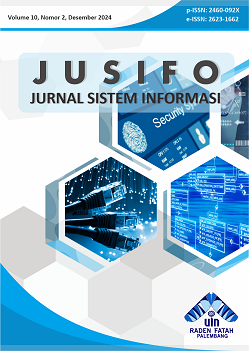Designing an Academic Advising Information System: A Human-Centered Design Approach
Main Article Content
Abstract
The digital transformation in higher education necessitates a reliable academic advising information system to enhance student support and academic decision-making. This study presents the design of an Academic Advising Information System using a Human-Centered Design (HCD) approach to address various challenges in academic advising, including ineffective communication, fragmented platforms, and inefficient documentation. By applying HCD principles, the system prioritizes usability, accessibility, and emotional considerations, ensuring an intuitive and supportive user experience for both students and academic advisors. This study follows an iterative development framework, integrating user insights through observations, interviews, and iterative improvements to refine system features such as advising history tracking and streamlined communication channels. The results indicate that the application of HCD effectively optimizes advising interactions, reduces administrative burdens, and enhances student engagement. This study contributes to the broader discourse on user-centered educational technology, emphasizing the importance of aligning digital solutions with user expectations. Future research should explore the scalability and adaptability of this system across various academic institutions to validate its broader applicability.
Article Details

This work is licensed under a Creative Commons Attribution-ShareAlike 4.0 International License.
Authors who publish with this journal agree to the following terms:
- Authors retain copyright and grant the journal right of first publication with the work simultaneously licensed under a Creative Commons Attribution License that allows others to share the work with an acknowledgement of the work's authorship and initial publication in this journal.
- Authors are able to enter into separate, additional contractual arrangements for the non-exclusive distribution of the journal's published version of the work (e.g., post it to an institutional repository or publish it in a book), with an acknowledgement of its initial publication in this journal.
- Authors are permitted and encouraged to post their work online (e.g., in institutional repositories or on their website) prior to and during the submission process, as it can lead to productive exchanges, as well as earlier and greater citation of published work.
How to Cite
References
Da Silva, T. S., Martin, A., Maurer, F., & Silveira, M. (2011). User-centered design and agile methods: a systematic review. Proceedings - 2011 Agile Conference, Agile 2011, 77–86. https://doi.org/10.1109/AGILE.2011.24
Dhandapani, S. (2016, November 16). Integration of user centered design and software development process. 7th IEEE Annual Information Technology, Electronics and Mobile Communication Conference, IEEE IEMCON 2016. https://doi.org/10.1109/IEMCON.2016.7746075
Endmann, A., & Keßner, D. (2016). User journey mapping – a method in user experience design. I-Com, 15(1), 105–110. https://doi.org/10.1515/ICOM-2016-0010
Hasim, W., Wibirama, S., & Nugroho, H. A. (2019). Redesign of e-participation using user-centered design approach for improving user experience. 2019 International Conference on Information and Communications Technology, ICOIACT 2019, 857–861. https://doi.org/10.1109/ICOIACT46704.2019.8938545
Hemidli, N. (2023). Introduction to ui/ux design: key concepts and principles. https://www.academia.edu/98036432/Introduction_to_UI_UX_Design_Key_Concepts_and_Principles
Hernández-Velázquez, Y., Mezura-Godoy, C., & Rosales-Morales, V. Y. (2021). M-Learning and Student-Centered Design: A Systematic Review of the Literature. Advances in Intelligent Systems and Computing, 1297, 349–363. https://doi.org/10.1007/978-3-030-63329-5_24
Kurniasih, S., Hendradewa, A. P., Sari, A. D., & Suryoputro, M. R. (2016). Redesign of a laboratory website using user centered design method and webuse. Advances in Intelligent Systems and Computing, 486, 153–161. https://doi.org/10.1007/978-3-319-41685-4_14
Lee, J. H., Kim, M. J., & Kim, S. W. (2015). A study customer journey map for user experience analysis of information and communications technology service. Lecture Notes in Computer Science (Including Subseries Lecture Notes in Artificial Intelligence and Lecture Notes in Bioinformatics), 9187, 66–74. https://doi.org/10.1007/978-3-319-20898-5_7/FIGURES/6
Li, M. (2019). Extended abstract: user journey mapping in course design and its application in technical communication pedagogy in china. IEEE International Professional Communication Conference, 2019-July, 253–254. https://doi.org/10.1109/PROCOMM.2019.00053
Lopes, A., Valentim, N., Moraes, B., Zilse, R., & Conte, T. (2018). Applying user-centered techniques to analyze and design a mobile application. Journal of Software Engineering Research and Development 2018 6:1, 6(1), 1–23. https://doi.org/10.1186/S40411-018-0049-1
Mizani, A., & Lubis, F. F. (2022). Evaluasi dan perbaikan desain interaksi edunex dengan pendekatan user-centered design. Jurnal Sistem Cerdas, 5(2), 83–91. https://doi.org/10.37396/JSC.V5I2.205
Norman, D. A. (2013). The design of everyday things: revised and expanded. MIT Press, London.
Norman, D. A. (2023). Design for a better world: meaningful, sustainable, humanity centered. MIT Press.
Norman, D. A., & Draper, S. W. (1986). User centered system design: new perspectives on human-computer interaction. CRC Press.
Puspitasari, I., Indah Cahyani, D., & Taufik, T. (2018). A user-centered design for redesigning e-government website in public health sector. Proceedings - 2018 International Seminar on Application for Technology of Information and Communication: Creative Technology for Human Life, ISemantic 2018, 219–224. https://doi.org/10.1109/ISEMANTIC.2018.8549726
Salinas, E., Cueva, R., & Paz, F. (2020). A systematic review of user-centered design techniques. Lecture Notes in Computer Science (Including Subseries Lecture Notes in Artificial Intelligence and Lecture Notes in Bioinformatics), 12200 LNCS, 253–267. https://doi.org/10.1007/978-3-030-49713-2_18/TABLES/6
Samson, S., Granath, K., & Alger, A. (2017). Journey mapping the user experience. College & Research Libraries, 78(4), 459. https://doi.org/10.5860/crl.78.4.459
Suprihatin, T. (2017). Prestasi akademik ditinjau dari model bimbingan akademik. Prosiding Temu Ilmiah Nasional X Ikatan Psikologi Perkembangan Indonesia, 1(0). https://jurnal.unissula.ac.id/index.php/ippi/article/view/2809
Wallach, D., & Scholz, S. C. (2012). User-centered design: why and how to put users first in software development. Management for Professionals, Part F393, 11–38. https://doi.org/10.1007/978-3-642-31371-4_2
Wilson, C. (2014). User interface inspection methods: a user-centered design method. Elsevier Inc.
Zaher, A. (2024). Academic advising: improving current practices. Enhancing Teaching and Learning in Higher Education, 1, 41–51. https://doi.org/10.62512/ETLHE.8
Zakiyatunufus, R. A. (2019). Layanan bimbingan akademik untuk meningkatkan prestasi akademik mahasiswa. Irsyad: Jurnal Bimbingan, Penyuluhan, Konseling, Dan Psikoterapi Islam, 7(2).

